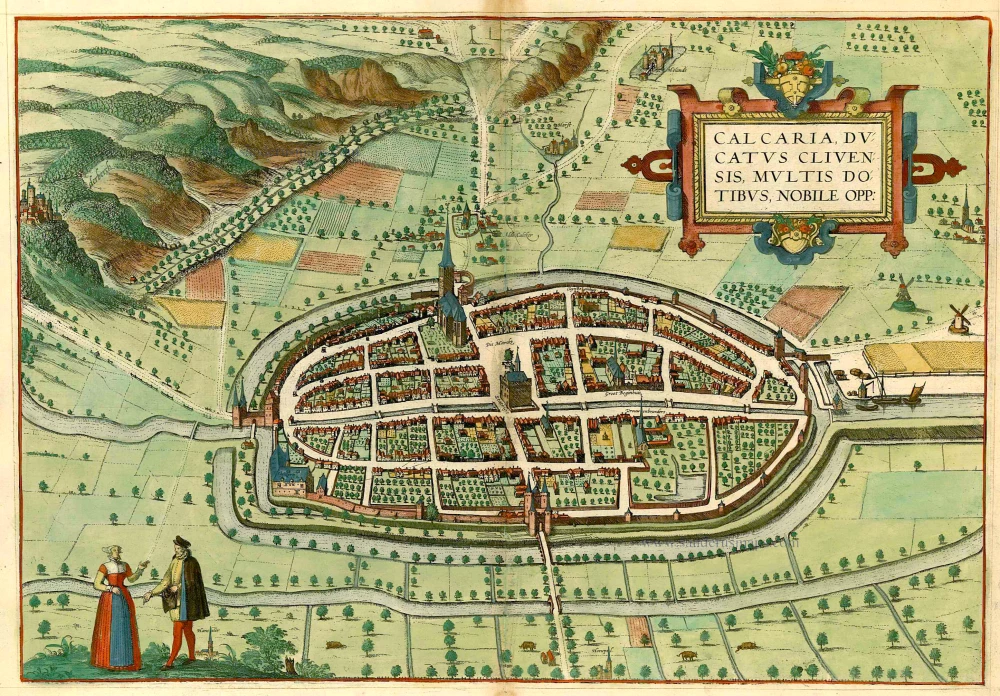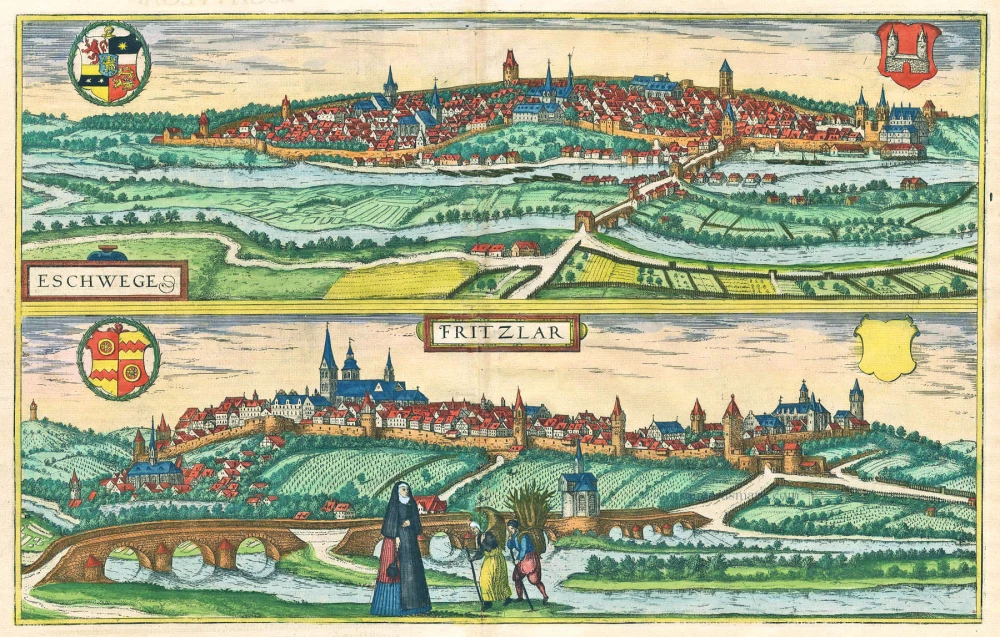Kalkar, by Braun & Hogenberg. 1575-1612
TRANSLATION OF CARTOUCHE TEXT: Kalkar, a town in the Duchy of Cleves, is well known for its many excellent qualities.
COMMENTARY BY BRAUN: "Kalkar was once built on an island in the Rhine by the Count of Cleves, as a defence against Cologne and Guelders, with whom the burghers of Cleves were constantly at war at that time. But now it is a breadbasket for all the surrounding villages and towns, for each week, the outlying farmers bring their corn and grain to market here. Kalkar is in a favourable location because the grain can be brought here on the Rhine in great ships. Kalkar has a good reputation, and its privileges make it one of the most distinguished towns in the Duchy of Cleves."
This bird's-eye view shows the city of Kalkar and its surroundings from the east. The magnificent gate in the middle of the plate is known as the Hanselaer gate. On the left-hand edge of the map can be seen Monterberg castle, one of the most important residences of the Counts of Cleves. In this plate, the town hall stands out clearly and the late Gothic church of St Nicholas, which was consecrated in 1450. On the marketplace stands the so-called court linden tree. North of the marketplace, a caption indicates the Beguinage. Kalkar was granted a municipal charter in 1242, and in the 14th century, it concluded an agreement with Goch and Emmerich regarding cloth production and wool processing. From 1540 to 1572, Kalkar was a Hanseatic city with a population of about 5,000. This prosperity ended in 1598 due to the Dutch Revolt against the Spanish. (Taschen)
Braun G. & Hogenberg F. and the Civitates Orbis Terrarum.
The Civitates Orbis Terrarum, also known as the 'Braun & Hogenberg', is a six-volume town atlas and the most excellent book of town views and plans ever published: 363 engravings, sometimes beautifully coloured. It was one of the best-selling works in the last quarter of the 16th century. Georg Braun, a skilled writer, wrote the text accompanying the plans and views on the verso. Many plates were engraved after the original drawings of a professional artist, Joris Hoefnagel (1542-1600). The first volume was published in Latin in 1572 and the sixth in 1617. Frans Hogenberg, a talented engraver, created the tables for volumes I through IV, and Simon van den Neuwel made those for volumes V and VI. Other contributors were cartographers Daniel Freese and Heinrich Rantzau, who provided valuable geographical information. Works by Jacob van Deventer, Sebastian Münster, and Johannes Stumpf were also used as references. Translations appeared in German and French, making the atlas accessible to a broader audience.
Since its original publication of volume 1 in 1572, the Civitates Orbis Terrarum has left an indelible mark on the history of cartography. Seven more editions followed the first volume in 1575, 1577, 1582, 1588, 1593, 1599, and 1612. Vol.2, initially released in 1575, saw subsequent editions in 1597 and 1612. The subsequent volumes, each a treasure trove of historical insights, graced the world in 1581, 1588, 1593, 1599, and 1606. The German translation of the first volume, a testament to its widespread appeal, debuted in 1574, followed by the French edition in 1575.
Several printers were involved: Theodor Graminaeus, Heinrich von Aich, Gottfried von Kempen, Johannis Sinniger, Bertram Buchholtz, and Peter von Brachel, all of whom worked in Cologne.
Georg Braun (1541-1622)
Georg Braun, the author of the text accompanying the plans and views in the Civitates Orbis Terrarum, was born in Cologne in 1541. After his studies in Cologne, he entered the Jesuit Order as a novice, indicating his commitment to learning and intellectual pursuits. In 1561, he obtained his bachelor's degree; in 1562, he received his Magister Artium, further demonstrating his academic achievements. Although he left the Jesuit Order, he continued his studies in theology, gaining a licentiate in theology. His theological background likely influenced the content and tone of the text in the Civitates Orbis Terrarum, adding a unique perspective to the work.
Frans Hogenberg (1535-1590)
Frans Hogenberg was a Flemish and German painter, engraver, and mapmaker. He was born in Mechelen as the son of Nicolaas Hogenberg.
By the end of the 1560s, Frans Hogenberg was employed upon Abraham Ortelius's Theatrum Orbis Terrarum, published in 1570; he is named an engraver of numerous maps. In 1568, he was banned from Antwerp by the Duke of Alva and travelled to London, where he stayed a few years before emigrating to Cologne. He immediately embarked on his two most important works, the Civitates, published in 1572 and the Geschichtsblätter, which appeared in several series from 1569 until about 1587.
Thanks to large-scale projects like the Geschichtsblätter and the Civitates, Hogenberg's social circumstances improved with each passing year. He died as a wealthy man in Cologne in 1590.
Calcaria Ducatus Clivensis, Multis Dotibus, Nobile Opp:
Item Number: 21753 Authenticity Guarantee
Category: Antique maps > Europe > Germany - Cities
Old, antique map of Kalkar by Braun & Hogenberg.
Title: Calcaria Ducatus Clivensis, Multis Dotibus, Nobile Opp:
Date: 1575-1612.
Copper engraving, printed on paper.
Size (not including margins): 330 x 475mm (12.99 x 18.7 inches).
Verso: Latin text.
Condition: Original coloured, excellent.
Condition Rating: A+.
From: Civitates Orbis Terrarum, ... Part 2. Köln, 1575-1612.
TRANSLATION OF CARTOUCHE TEXT: Kalkar, a town in the Duchy of Cleves, is well known for its many excellent qualities.
COMMENTARY BY BRAUN: "Kalkar was once built on an island in the Rhine by the Count of Cleves, as a defence against Cologne and Guelders, with whom the burghers of Cleves were constantly at war at that time. But now it is a breadbasket for all the surrounding villages and towns, for each week, the outlying farmers bring their corn and grain to market here. Kalkar is in a favourable location because the grain can be brought here on the Rhine in great ships. Kalkar has a good reputation, and its privileges make it one of the most distinguished towns in the Duchy of Cleves."
This bird's-eye view shows the city of Kalkar and its surroundings from the east. The magnificent gate in the middle of the plate is known as the Hanselaer gate. On the left-hand edge of the map can be seen Monterberg castle, one of the most important residences of the Counts of Cleves. In this plate, the town hall stands out clearly and the late Gothic church of St Nicholas, which was consecrated in 1450. On the marketplace stands the so-called court linden tree. North of the marketplace, a caption indicates the Beguinage. Kalkar was granted a municipal charter in 1242, and in the 14th century, it concluded an agreement with Goch and Emmerich regarding cloth production and wool processing. From 1540 to 1572, Kalkar was a Hanseatic city with a population of about 5,000. This prosperity ended in 1598 due to the Dutch Revolt against the Spanish. (Taschen)
Braun G. & Hogenberg F. and the Civitates Orbis Terrarum.
The Civitates Orbis Terrarum, also known as the 'Braun & Hogenberg', is a six-volume town atlas and the most excellent book of town views and plans ever published: 363 engravings, sometimes beautifully coloured. It was one of the best-selling works in the last quarter of the 16th century. Georg Braun, a skilled writer, wrote the text accompanying the plans and views on the verso. Many plates were engraved after the original drawings of a professional artist, Joris Hoefnagel (1542-1600). The first volume was published in Latin in 1572 and the sixth in 1617. Frans Hogenberg, a talented engraver, created the tables for volumes I through IV, and Simon van den Neuwel made those for volumes V and VI. Other contributors were cartographers Daniel Freese and Heinrich Rantzau, who provided valuable geographical information. Works by Jacob van Deventer, Sebastian Münster, and Johannes Stumpf were also used as references. Translations appeared in German and French, making the atlas accessible to a broader audience.
Since its original publication of volume 1 in 1572, the Civitates Orbis Terrarum has left an indelible mark on the history of cartography. Seven more editions followed the first volume in 1575, 1577, 1582, 1588, 1593, 1599, and 1612. Vol.2, initially released in 1575, saw subsequent editions in 1597 and 1612. The subsequent volumes, each a treasure trove of historical insights, graced the world in 1581, 1588, 1593, 1599, and 1606. The German translation of the first volume, a testament to its widespread appeal, debuted in 1574, followed by the French edition in 1575.
Several printers were involved: Theodor Graminaeus, Heinrich von Aich, Gottfried von Kempen, Johannis Sinniger, Bertram Buchholtz, and Peter von Brachel, all of whom worked in Cologne.
Georg Braun (1541-1622)
Georg Braun, the author of the text accompanying the plans and views in the Civitates Orbis Terrarum, was born in Cologne in 1541. After his studies in Cologne, he entered the Jesuit Order as a novice, indicating his commitment to learning and intellectual pursuits. In 1561, he obtained his bachelor's degree; in 1562, he received his Magister Artium, further demonstrating his academic achievements. Although he left the Jesuit Order, he continued his studies in theology, gaining a licentiate in theology. His theological background likely influenced the content and tone of the text in the Civitates Orbis Terrarum, adding a unique perspective to the work.
Frans Hogenberg (1535-1590)
Frans Hogenberg was a Flemish and German painter, engraver, and mapmaker. He was born in Mechelen as the son of Nicolaas Hogenberg.
By the end of the 1560s, Frans Hogenberg was employed upon Abraham Ortelius's Theatrum Orbis Terrarum, published in 1570; he is named an engraver of numerous maps. In 1568, he was banned from Antwerp by the Duke of Alva and travelled to London, where he stayed a few years before emigrating to Cologne. He immediately embarked on his two most important works, the Civitates, published in 1572 and the Geschichtsblätter, which appeared in several series from 1569 until about 1587.
Thanks to large-scale projects like the Geschichtsblätter and the Civitates, Hogenberg's social circumstances improved with each passing year. He died as a wealthy man in Cologne in 1590.


